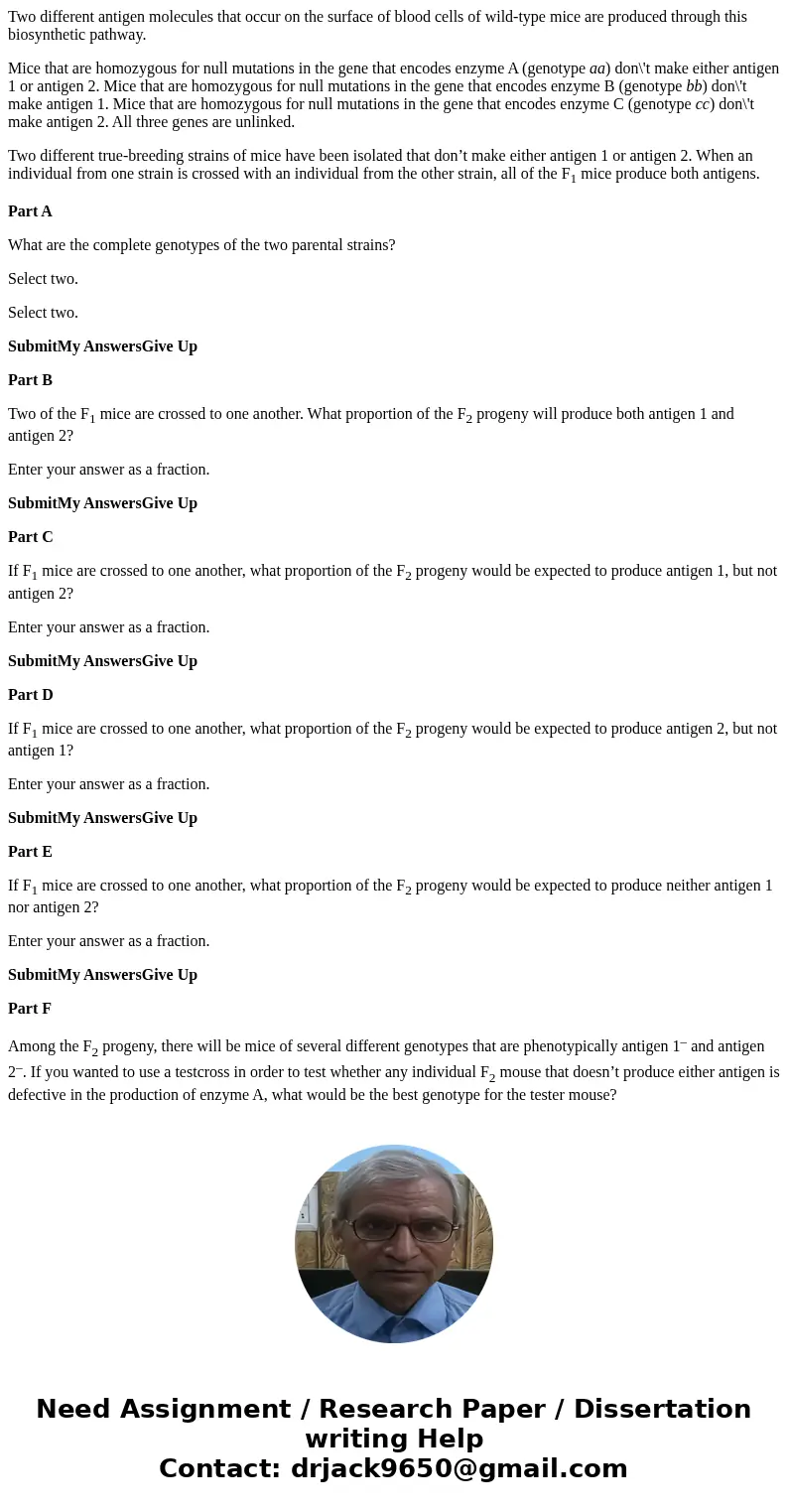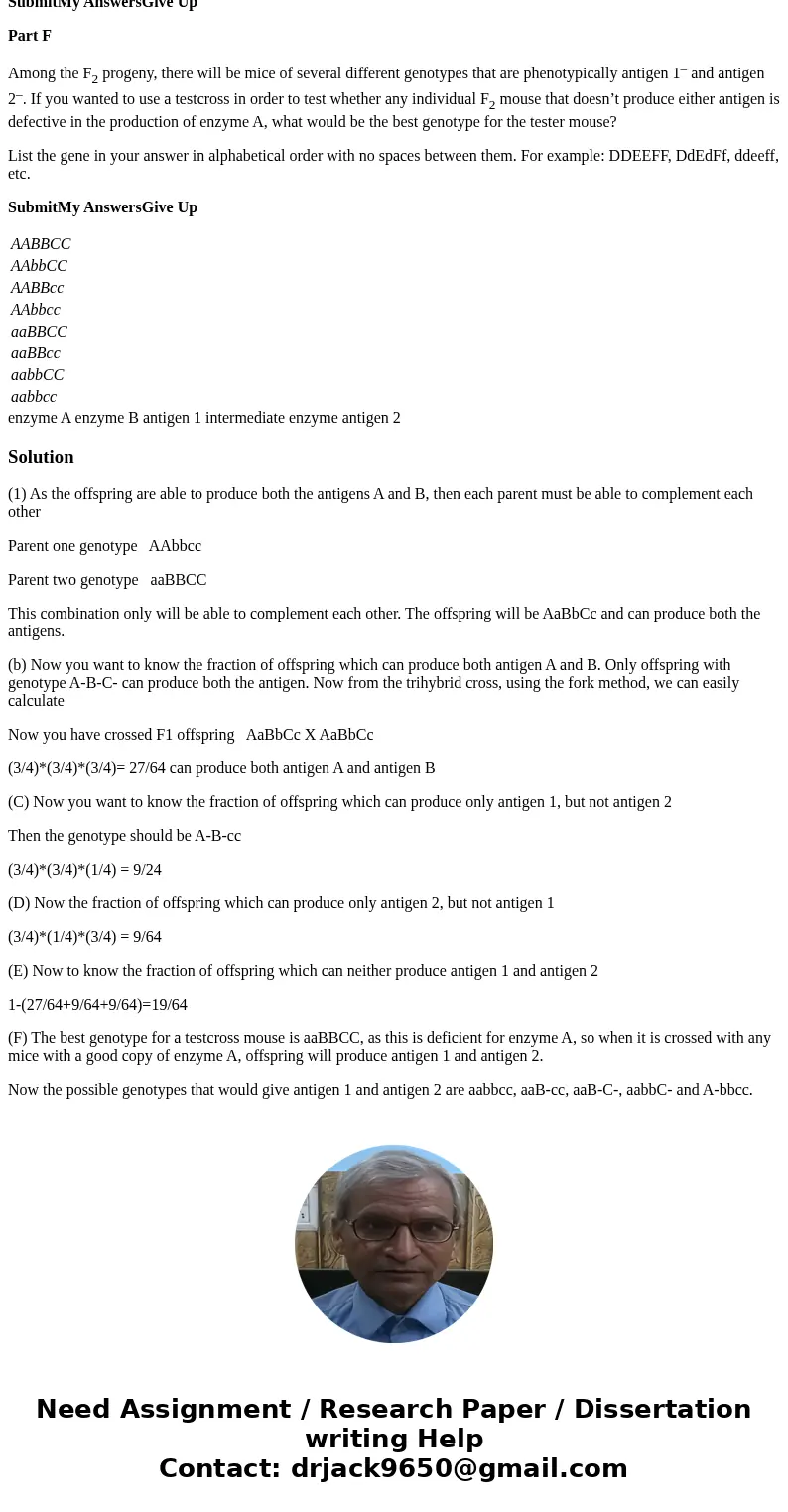Two different antigen molecules that occur on the surface of
Two different antigen molecules that occur on the surface of blood cells of wild-type mice are produced through this biosynthetic pathway.
Mice that are homozygous for null mutations in the gene that encodes enzyme A (genotype aa) don\'t make either antigen 1 or antigen 2. Mice that are homozygous for null mutations in the gene that encodes enzyme B (genotype bb) don\'t make antigen 1. Mice that are homozygous for null mutations in the gene that encodes enzyme C (genotype cc) don\'t make antigen 2. All three genes are unlinked.
Two different true-breeding strains of mice have been isolated that don’t make either antigen 1 or antigen 2. When an individual from one strain is crossed with an individual from the other strain, all of the F1 mice produce both antigens.
Part A
What are the complete genotypes of the two parental strains?
Select two.
Select two.
SubmitMy AnswersGive Up
Part B
Two of the F1 mice are crossed to one another. What proportion of the F2 progeny will produce both antigen 1 and antigen 2?
Enter your answer as a fraction.
SubmitMy AnswersGive Up
Part C
If F1 mice are crossed to one another, what proportion of the F2 progeny would be expected to produce antigen 1, but not antigen 2?
Enter your answer as a fraction.
SubmitMy AnswersGive Up
Part D
If F1 mice are crossed to one another, what proportion of the F2 progeny would be expected to produce antigen 2, but not antigen 1?
Enter your answer as a fraction.
SubmitMy AnswersGive Up
Part E
If F1 mice are crossed to one another, what proportion of the F2 progeny would be expected to produce neither antigen 1 nor antigen 2?
Enter your answer as a fraction.
SubmitMy AnswersGive Up
Part F
Among the F2 progeny, there will be mice of several different genotypes that are phenotypically antigen 1– and antigen 2–. If you wanted to use a testcross in order to test whether any individual F2 mouse that doesn’t produce either antigen is defective in the production of enzyme A, what would be the best genotype for the tester mouse?
List the gene in your answer in alphabetical order with no spaces between them. For example: DDEEFF, DdEdFf, ddeeff, etc.
SubmitMy AnswersGive Up
| AABBCC |
| AAbbCC |
| AABBcc |
| AAbbcc |
| aaBBCC |
| aaBBcc |
| aabbCC |
| aabbcc |
Solution
(1) As the offspring are able to produce both the antigens A and B, then each parent must be able to complement each other
Parent one genotype AAbbcc
Parent two genotype aaBBCC
This combination only will be able to complement each other. The offspring will be AaBbCc and can produce both the antigens.
(b) Now you want to know the fraction of offspring which can produce both antigen A and B. Only offspring with genotype A-B-C- can produce both the antigen. Now from the trihybrid cross, using the fork method, we can easily calculate
Now you have crossed F1 offspring AaBbCc X AaBbCc
(3/4)*(3/4)*(3/4)= 27/64 can produce both antigen A and antigen B
(C) Now you want to know the fraction of offspring which can produce only antigen 1, but not antigen 2
Then the genotype should be A-B-cc
(3/4)*(3/4)*(1/4) = 9/24
(D) Now the fraction of offspring which can produce only antigen 2, but not antigen 1
(3/4)*(1/4)*(3/4) = 9/64
(E) Now to know the fraction of offspring which can neither produce antigen 1 and antigen 2
1-(27/64+9/64+9/64)=19/64
(F) The best genotype for a testcross mouse is aaBBCC, as this is deficient for enzyme A, so when it is crossed with any mice with a good copy of enzyme A, offspring will produce antigen 1 and antigen 2.
Now the possible genotypes that would give antigen 1 and antigen 2 are aabbcc, aaB-cc, aaB-C-, aabbC- and A-bbcc.


 Homework Sourse
Homework Sourse